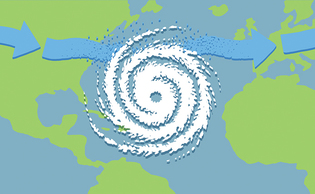
Gregory Nemec
Stormy weather: Tropical cyclones, also known as hurricanes or typhoons, are usually more intense and destructive in lower latitudes. But a Yale-led study shows that the powerful storms are likely to migrate further northward (looking at you, coastal New England) and southward in their respective hemispheres as human-made emissions continue to warm the earth.
These storms usually form above tropical ocean waters and away from interference by the jet stream winds that circle the planet. As the climate warms, temperature differences between the equator and the poles will decrease. In the summers of each north-south hemisphere, this warming may cause weakening or splitting in the jet stream, allowing tropical cyclones to form and intensify in the mid-latitudes—the area between the tropics and the polar circles.
Heading off aneurysms: Each year, some 30,000 Americans suffer a ruptured brain aneurysm. One in four dies before reaching a hospital. Another 25 percent die of complications within six months.
About three percent of the US population has the most common kind of brain aneurysm—a bulge in a blood vessel wall—but finding those at risk is difficult. Most intact aneurysms cause no symptoms; those about to rupture are often asymptomatic. (They may cause headaches or vision changes.)
Now, Yale researchers have identified the role of PPIL4, a gene crucial for creating blood vessels in the developing brain. PPIL4 mutations were a common factor in the genomes of over 300 intracranial aneurysm patients analyzed by the team. Cardiovascular Research Center codirector Stefania Nicoli says PPIL4 is “like a time machine”: it helps the researchers “find the origins of the aneurysms.”
 loading
loading